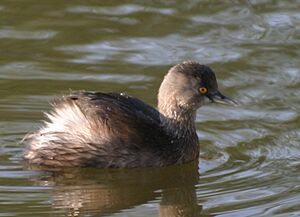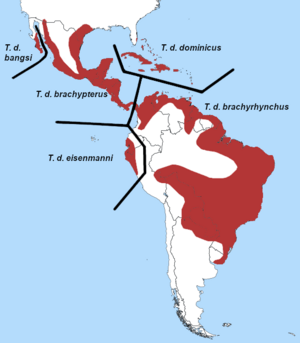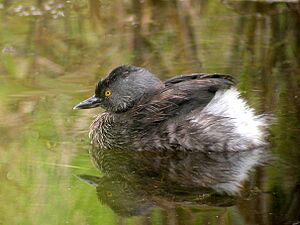Least grebe facts for kids
Quick facts for kids Least grebe |
|
|---|---|
 |
|
| Conservation status | |
| Scientific classification | |
 |
|
| Range of T. dominicus Subspecies separated by black lines |
|
| Synonyms | |
|
Colymbus dominicus Linnaeus, 1766 |
The least grebe (Tachybaptus dominicus) is a small water bird. It is the smallest member of the grebe family. You can find this bird in the New World, from the southwestern United States and Mexico all the way down to Argentina. It also lives on islands like Trinidad and Tobago, the Bahamas, and the Greater Antilles.
Contents
About the Least Grebe
The least grebe is quite small. It is usually about 21 to 27 centimeters (8 to 11 inches) long. It weighs around 112 to 180 grams (4 to 6 ounces). Even the largest least grebes are smaller and lighter than any other grebe species.
Like all grebes, its legs are set far back on its body. This means it cannot walk very well on land. However, it is an excellent swimmer and diver in the water. This bird is plump with a short, pointed beak and bright yellow eyes. It usually looks quite dark all over its body.
Adult grebes that are ready to breed are brownish-grey on top. They have a darker, almost black, crown and throat. Their chest is brownish, and their belly is pale. When they fly, you can see a white patch on their wings. Birds that are not breeding are paler. Young grebes are even lighter and greyer than adults.
Least Grebe Family Tree
Scientists recognize five different types, or subspecies, of the least grebe. These types are mainly different in their size and color.
- T. d. brachypterus: This type lives from southern Texas and Mexico down to Panama.
- T. d. bangsi: This type is found only in southern Baja California, Mexico. It is the smallest and palest of all the types.
- T. d. dominicus: This is the main type. It lives in the northern Caribbean, including the Bahamas, Greater Antilles, Virgin Islands, and southern Florida.
- T. d. brachyrhynchus or T. d. speciosus: This type lives in South America. You can find it from Colombia, Venezuela, and Trinidad and Tobago south to northern Argentina and southern Brazil.
- T. d. eisenmanni: This type is found only in the lowlands of western Ecuador. Not all scientists agree that this is a separate type.
The name of its group, Tachybaptus, comes from two Greek words. Takhus means fast, and baptos means diving or sinking. The name dominicus refers to the Caribbean island of Hispaniola. This island was once known as Santo Domingo. The least grebe is the only member of its group found in the New World. The four other members of the Tachybaptus group live in the Old World and Australasia.
Where Least Grebes Live
Least grebes live in many different wetland areas. These include freshwater ponds, lakes, and marshes. They also live in slow-moving streams and rivers, roadside ditches, and mangrove swamps.
They usually prefer water bodies with lots of plants, especially along the edges. They might even use wetlands that are almost completely covered with plants. Sometimes, they choose small, temporary water spots to breed. This helps them avoid large fish that might eat their chicks.
Least Grebe Behavior
Most of the year, you will find least grebes alone or in pairs. However, when they are not breeding, they sometimes gather in groups of 20 or more birds.
What Least Grebes Eat
The least grebe eats many kinds of water creatures. These include small fish, crustaceans like shrimp, frogs, and aquatic insects. Like all grebes, it hunts much of its food underwater. When it is actively feeding, it stays underwater for about 12.5 seconds per dive. It then pauses on the surface for 2 to 24 seconds before diving again.
Reproduction and Life Cycle
Least grebes can breed throughout the year. Those living in tropical areas tend to breed during the rainy season. In Texas, active nests have been found in every month of the year.
Each pair builds a small, floating nest made of plants. They use different kinds of water weeds. The nest is tied to rooted plants in calm, open water. The water can be as deep as 1.5 meters (5 feet). The female lays three to six white eggs. The damp nest material soon stains the eggs brown. Both parents take turns sitting on the eggs. The eggs hatch after 21 days. The young grebes have stripes. Sometimes, the parents carry their striped young on their backs.
Least Grebe Sounds
The call of a breeding least grebe sounds like a horse whinnying.
Threats to Least Grebes
The least grebe is considered a species of least concern. This means it is not currently in danger of disappearing. However, it does face some threats, especially when it is young. Large fish and turtles are known to eat young grebes. Also, birds that hunt other birds, like the bat falcon and the golden eagle, have been seen catching adult grebes.



